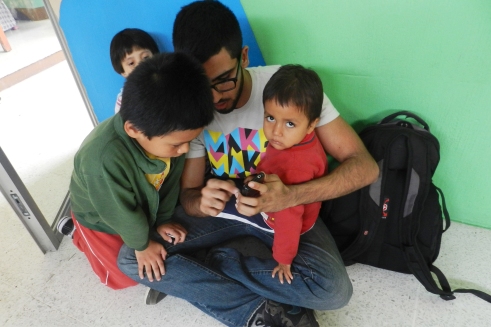By CANTON WINER

Photo courtesy of Stasha O’Callaghan
Sohail Qazi, a student. teaches children from the Sanatorino Hermano Pedro malnutrition clinic how to play Bejewled.
Few college students who go abroad during their breaks gush about observing laparoscopic gallbladder removal surgery. Yet, seven Fordham University students who traveled to Guatemala for one week in January say this was exactly the experience they were hoping for.
These students were among the first group to participate in the Guatemala City Service Abroad Experience for pre-health students at Fordham, which took place from Jan. 6-13. The students met with faculty from Francisco Marroquín University to learn about education and the healthcare system in Guatemala, had the opportunity to interact with Guatemalan patients and, on several occasions, observe surgery.
“I cannot imagine having taken part in a better experience,” Danielle Espinoza, FCRH ’14, said in an email. “The group of Fordham students I traveled with all shared my enthusiasm and working with them was a pleasure.”
Though the trip was aimed toward pre-health students, students were exposed to ideas that reached into other academic fields as well.
“There ended up being two parts of the trip, the medical aspects and the sociocultural aspects,” Stasha O’Callaghan, FCRH ’14, said in an email.
In Centro de Salud Bárbara in San Juan Sacatepéquez, Dr. Mauel Diez Cabrera, chairman for Francisco Marroquín University’s rural public health program, spoke to the Fordham students about the challenges of healthcare in Guatemala.
“We learned about the harsh realities faced by indigenous groups when it comes to healthcare and the lack of resources available,” Espinoza said. “I came to understand how culture and traditions can have a strong impact on the treatment received (or rejected) by the inhabitants.”
While several of the students had experience in American healthcare, they said that the conditions in Guatemala were often shocking.
“In our visit to Sanatorio Hermano Pedro I was able to interact with undernourished children and the sisters and nurses who care for them,” Espinoza said. “It was heartbreaking to see the conditions children came in and to learn that their parents could only visit them once a week while they recuperated.”
Students also observed the disparity between the quality of public and private hospitals in Guatemala City.
“The contrast between the care in the public and private hospitals was extreme,” O’Callaghan said. “Hospital Esperanza, the private one, had barely any patients, a new CAT scan machine and beautiful green grounds surrounding it. The public [hospital] reeked of urine, had patients bleeding profusely in the waiting room patiently waiting for a bed and separate wards for men and women due to a past history of rape occurring in the hospital.”
The students also experienced some of the unsanitary living conditions in Guatemala firsthand. One afternoon, they went to the city dump, which is the size of about “40 football fields,” and is peppered by hundreds of swarming vultures, O’Callaghan said. City dwellers desperately scrounge the dumps looking for anything to sell.
“Small children sneak into the dump and are often run over by trucks,” said O’Callaghan. “It couldn’t have been a more awful place.”
Despite many somber moments, students left with cheerier memories as well.
“It was inspiring to see the smiles and ebullience that the children [at Sanatorio Hermano Pedro] carried,” Espinoza said. “I won’t ever forget the expressions of joy on the faces of the young girls receiving donated dresses.”
On Saturday, Jan. 12, the group hiked the Pacaya volcano, which last erupted in 2010.
“Walking through the hardened lava seeing some greenery coming back, breathing the thin air and ultimately getting to roast marshmallows in an extra hot area of rock was extremely beautiful and memorable,” O’Callaghan said.
Luz Lenis, FCRH assistant dean for sophomores and an organizer of the trip, was enthusiastic about the success of the program. She emphasized that the unique, Fordham-developed program had many structural advantages for Fordham students over pre-existing programs offered by other universities.
“In developing a Fordham-specific program, we will be able to control many of its major, critical elements – for instance, the program’s design, length, participation, cost, etc.,” Lenis said in a report, which she completed with International and Study Abroad Programs (ISAP) Director Mendez Clark, on the trip. “This is a major difference from the basic structures of those other programs already in existence.”
Among the participants, the trip appeared a unanimous success.
“This trip definitely reinforced my desire to become a physician and my desire to do something about this unequal distribution of wealth, no matter how small, with my life’s efforts,” O’Callaghan said.
